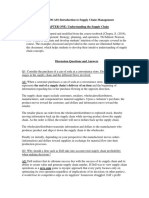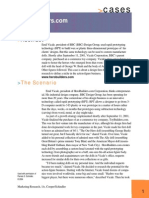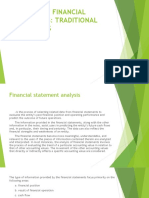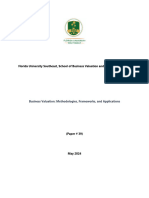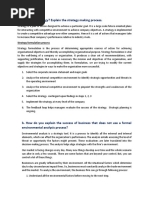Retail Industry
Retail Industry
Uploaded by
akavinashkillerCopyright:
Available Formats
Retail Industry
Retail Industry
Uploaded by
akavinashkillerCopyright
Available Formats
Share this document
Did you find this document useful?
Is this content inappropriate?
Copyright:
Available Formats
Retail Industry
Retail Industry
Uploaded by
akavinashkillerCopyright:
Available Formats
PEFINDO Rating Criteria & Methodology
Retail Industry - Key Success Factors
BUSINESS RISK ASSESSMENT
Market Position
The analysis covers comprehensive assessments on the company's competitive market position, which
could be quantitatively and qualitatively determined using the company's market share, size in terms of
sales value and coverage, brand recognition, as well as its growth history and anticipated growth prospect
going forward. The analysis also cover the assessments on the company's ability in providing good services
and quality merchandises with competitive prices, which would satisfy customer demand and positively
affect the company's performance in both business and financial sides. Moreover, the company's strategy
to address the challenges in response to changes and potential changes in the marketplace is highly
considered, since inability to successfully identify and exploit new markets or opportunities would negatively
influence its future operating results. In addition, types of retailing activities are taken into account, as
different types of retailing vary in terms of barriers to entry, fashion and obsolescence risks, cyclicality and
seasonality. The company's customer base, store concept/format and pricing policy are also considered in
the rating assessments.
Marketing and Distribution Channel
The analysis covers diligent reviews on the company's marketing policy, strategy, and distribution network
in an effort to attract customers and provide good shopping experiences and conveniences for customers.
In general, good and innovative marketing and merchandising, as well as store/layout remodeling and
renovation programs can stimulate sales. The assessments also consider the development of a strong
private-label business as a value alternative for consumers, which could retain customer loyalty and provide
better margins. Moreover, the company's number of outlets and other supporting facilities in strategic
locations in order to come closer to customers, and the company's market expansion strategy (aggressive
vs. conservative) are also incorporated in the rating consideration.
Diversification
The analysis includes risk assessments on the company's diversification strategy and policy in terms of
products, store formats, target customers and geographic coverage in an effort to maintain steady revenue
stream. In general, excellent strategy of product mix/merchandise assortments to fulfill its target market's
necessities, appropriate store formats to cater different customers' segments and sufficient geographic
diversity of the company's outlets to improve sales are important factors in retail industry to successfully
do business.
Operating Management
The analysis include thorough reviews on how well the company manages its daily business operation, as
a failure to effectively and efficiently manage the operation would adversely affect the company's future
operating results. The company's cost control strategy and policy is also diligently assessed, as the
company's strong ability to control costs is crucial, particularly in the fiercer competition business
environment. The analysis on operating margins (EBIT and EBITDA) is also assessed by comparing the
company’s ratios with other players in the same industry or other industry with similar characteristic, which
is important in analyzing the company’s competitiveness. The analysis is helpful to measure operating
efficiency and the company’s flexibility in adjusting selling price. The company's inventory strategy and
policy is also analyzed, as a good inventory management will minimize slow moving and/or obsolete
inventory so that there will be lower inventory costs, thus lead to lower and competitive merchandise prices.
The use of information technology especially in inventory management to monitor flow of goods in order
to have more efficient operation in terms of time and cost and the company's purchasing power with
respect to suppliers are also incorporated in the rating consideration. Generally, larger players have
http://www.pefindo.com 1/3 November 29, 2022
PEFINDO Rating Criteria & Methodology
competitive advantages, as they have stronger bargaining power and economies of scale in transportation,
logistics, purchasing and advertising.
FINANCIAL RISK ASSESSMENT
Financial Policy
The analysis includes a review of management's philosophy, strategy and policies toward financial risk
(historical, current and future). It also includes examination of management's financial targets (growth,
leverage, debt structure and dividend policy), hedging and other policies in an effort to reduce the
company's overall financial risk (historical vs. future). The company's track record on fulfilling its previous
financial obligations is also examined to determine the degree of its commitments and willingness and
consistency to pay obligations on a timely basis.
Capital Structure
The analysis covers careful examination of the company's historical, current and projected leverage (total
and net debt in relation to equity and EBITDA), debt structures and composition (rupiah vs. foreign
currencies, short-term debt vs. long-term debt, fixed rate vs. floating rate). Management of its liabilities is
also thoroughly reviewed.
Cash Flow Protection And Liquidity
The analysis covers thorough reviews of the company's cash flow generation and capability to meet its
short-term and long-term financial obligations. The degree of its debt-servicing capability level is measured
by the company's interest and debt coverage ratio. The degree of its liquidity in fulfilling its short-term
liabilities relative to its sources of cash is also thoroughly assessed. The sources of cash are assessed, which
include cash balance, estimated cash from operations, unused credit facilities, and other sources of cash.
The uses of cash other than short-term liabilities, such as capital expenditure, are also assessed.
Financial Flexibility
The analysis covers combined evaluations of all the financial measures above to arrive at an overall view
of the company's financial health. Analysis of other related factors or figures that are not specifically
examined above, such as insurance coverage, restrictive covenants in loan/bond agreements or parental
linkage and support, are also covered. Other analytical tasks covered are the evaluation of the company's
options under stress, including contingency plans and other capabilities and flexibility to deal with various
adverse scenarios. Shareholder support and commitment are also greatly considered.
http://www.pefindo.com 2/3 November 29, 2022
PEFINDO Rating Criteria & Methodology
DISCLAIMER
The rating contained in this report or publication is the opinion of PT Pemeringkat Efek Indonesia (PEFINDO) given based on the
rating result on the date the rating was made. The rating is a forward-looking opinion regarding the rated party’s capability to meet
its financial obligations fully and on time, based on assumptions made at the time of rating. The rating is not a recommendation for
investors to make investment decisions (whether the decision is to buy, sell, or hold any debt securities based on or related to the
rating or other investment decisions) and/or an opinion on the fairness value of debt securities and/or the value of the entity assigned
a rating by PEFINDO. All the data and information needed in the rating process are obtained from the party requesting the rating,
which are considered reliable in conveying the accuracy and correctness of the data and information, as well as from other sources
deemed reliable. PEFINDO does not conduct audits, due diligence, or independent verifications of every information and data received
and used as basis in the rating process. PEFINDO does not take any responsibility for the truth, completeness, timeliness, and accuracy
of the information and data referred to. The accuracy and correctness of the information and data are fully the responsibility of the
parties providing them. PEFINDO and every of its member of the Board of Directors, Commissioners, Shareholders and Employees
are not responsible to any party for losses, costs and expenses suffered or that arise as a result of the use of the contents and/or
information in this rating report or publication, either directly or indirectly. PEFINDO generally receives fees for its rating services from
parties who request the ratings, and PEFINDO discloses its rating fees prior to the rating assignment. PEFINDO has a commitment in
the form of policies and procedures to maintain objectivity, integrity, and independence in the rating process. PEFINDO also has a
“Code of Conduct” to avoid conflicts of interest in the rating process. Ratings may change in the future due to events that were not
anticipated at the time they were first assigned. PEFINDO has the right to withdraw ratings if the data and information received are
determined to be inadequate and/or the rated company does not fulfill its obligations to PEFINDO. For ratings that received approval
for publication from the rated party, PEFINDO has the right to publish the ratings and analysis in its reports or publication, and publish
the results of the review of the published ratings, both periodically and specifically in case there are material facts or important events
that could affect the previous ratings. Reproduction of the contents of this publication, in full or in part, requires written approval
from PEFINDO. PEFINDO is not responsible for publications by other parties of contents related to the ratings given by PEFINDO.
http://www.pefindo.com 3/3 November 29, 2022
You might also like
- Ollopa Corporation Company Profile - Revised 5 1Document19 pagesOllopa Corporation Company Profile - Revised 5 1Lyka FerrerNo ratings yet
- Ch01-Discussion Questions and AnswersDocument3 pagesCh01-Discussion Questions and Answerseeman kNo ratings yet
- Create and Sell Online Courses Guide 1Document54 pagesCreate and Sell Online Courses Guide 1charbel_945100% (1)
- Case StudyDocument2 pagesCase Studyed50% (4)
- Automotive Industry - Key Success Factors: Business Risk Assessment Market PositionDocument3 pagesAutomotive Industry - Key Success Factors: Business Risk Assessment Market PositionraghulNo ratings yet
- Manufacturing Bisnis N Finance RaiskDocument2 pagesManufacturing Bisnis N Finance RaiskFerlyan Huang 正莲No ratings yet
- Information Technology & IT Services IndustryDocument3 pagesInformation Technology & IT Services IndustryAlukwu JudeNo ratings yet
- Tobacco Industry - Key Success Factors: Business Risk Assessment Market PositionDocument3 pagesTobacco Industry - Key Success Factors: Business Risk Assessment Market PositionGunadeep ReddyNo ratings yet
- Key Success Factors of The Pharmaceutical IndsustryDocument2 pagesKey Success Factors of The Pharmaceutical Indsustrybenj_morgan100% (1)
- Key Success Facotr GeneralDocument3 pagesKey Success Facotr GeneralprashantNo ratings yet
- Special Financial Institution IndustryDocument2 pagesSpecial Financial Institution IndustryAVINASH KUMAR SINGHNo ratings yet
- Electricity Power Industry - Key Success Factors: Business Risk Assessment RegulationDocument2 pagesElectricity Power Industry - Key Success Factors: Business Risk Assessment Regulationanubhav saxenaNo ratings yet
- Mining Industry - Key Success Factors: Business Risk Assessment Cost PositionDocument2 pagesMining Industry - Key Success Factors: Business Risk Assessment Cost PositionJonas ArifinNo ratings yet
- sannuDocument65 pagessannujatin.948586No ratings yet
- Banking Industry KSFDocument3 pagesBanking Industry KSFAdam AmruNo ratings yet
- BANKING INDUSTRY - Key Success Factors: Business Risk Assessment Market PositionDocument2 pagesBANKING INDUSTRY - Key Success Factors: Business Risk Assessment Market PositionGary YuthianNo ratings yet
- Uses of Financial Statement AnalysisDocument9 pagesUses of Financial Statement Analysisdia.gambhir2004No ratings yet
- Banking Industry - Key Success Factors: Business Risk Assessment Market PositionDocument2 pagesBanking Industry - Key Success Factors: Business Risk Assessment Market PositionrahidarzooNo ratings yet
- Business Finance Chapter 4Document15 pagesBusiness Finance Chapter 4chloe frostNo ratings yet
- Business Finance Chapter 4Document15 pagesBusiness Finance Chapter 4chloe frostNo ratings yet
- Critical Succucess FactorDocument3 pagesCritical Succucess FactorHimansh SagarNo ratings yet
- Security AnalysisDocument12 pagesSecurity AnalysisMa. Donabel BulanNo ratings yet
- Financial Analysis 1Document5 pagesFinancial Analysis 15555-899341No ratings yet
- Veena.r4TH SEM FINAL PROJECT (FINAL COPY)Document62 pagesVeena.r4TH SEM FINAL PROJECT (FINAL COPY)Mamatha NUNo ratings yet
- Financial Analytics NotesDocument38 pagesFinancial Analytics Notessridhara.ramkarthik173No ratings yet
- XCFBJJKMDocument33 pagesXCFBJJKMApurbh Singh KashyapNo ratings yet
- Objectives of Credit Rating: Financial Statements CreditworthinessDocument6 pagesObjectives of Credit Rating: Financial Statements CreditworthinessvishNo ratings yet
- Pavan ProjectDocument44 pagesPavan Project084 UjwalaNo ratings yet
- Strategic Planning and Project ManagementDocument3 pagesStrategic Planning and Project Managementbtsvt1307 phNo ratings yet
- QuestionsDocument2 pagesQuestionsJoe DicksonNo ratings yet
- The Strategic Planning ProcessDocument10 pagesThe Strategic Planning ProcessSyed Faiz QuadriNo ratings yet
- WWW Investopedia Com Terms F Fundamentalanalysis ASPDocument15 pagesWWW Investopedia Com Terms F Fundamentalanalysis ASPRon TraskNo ratings yet
- Toll Road Industry - Key Success Factors: Business Risk Assessment Economy of Service AreaDocument3 pagesToll Road Industry - Key Success Factors: Business Risk Assessment Economy of Service Arealuqm4n99No ratings yet
- Financial Analysis and Accounting BasicsDocument23 pagesFinancial Analysis and Accounting BasicsisaackotachieNo ratings yet
- Reaction Paper On The Said 4 TopicsDocument8 pagesReaction Paper On The Said 4 TopicsBjayNo ratings yet
- Financial Diagnosis - Approaches and ComplementaritiesDocument4 pagesFinancial Diagnosis - Approaches and ComplementaritiesCristina CristianNo ratings yet
- Management03102024-StudyGuideDocument35 pagesManagement03102024-StudyGuideatangjade7No ratings yet
- Manufacturing CompaniesDocument5 pagesManufacturing CompaniesVineet_Sharma_9432No ratings yet
- I. Overview of Financial Statement AnalysisDocument70 pagesI. Overview of Financial Statement AnalysisGeofrey RiveraNo ratings yet
- Accounting Class With Teacher CDocument7 pagesAccounting Class With Teacher CMinh BìnhNo ratings yet
- Final Assignment - Business EthicsDocument8 pagesFinal Assignment - Business EthicssidainejpetersNo ratings yet
- M&a FormationDocument5 pagesM&a FormationJoseph GohNo ratings yet
- CHAPTER 6hshshsWPS OfficeDocument78 pagesCHAPTER 6hshshsWPS OfficeKris Van HalenNo ratings yet
- Perspectives in Balanced ScorecardDocument6 pagesPerspectives in Balanced ScorecardInah SalcedoNo ratings yet
- Financial AnalysisDocument10 pagesFinancial Analysisrudy.escobar0823No ratings yet
- Importance of Benchmarking in Ratio AnalysisDocument3 pagesImportance of Benchmarking in Ratio Analysisritvikjain2007No ratings yet
- Business Valuation - Methodologies, Frameworks, and ApplicationsDocument8 pagesBusiness Valuation - Methodologies, Frameworks, and ApplicationsAnwar AdemNo ratings yet
- I. Overview of Financial Statement AnalysisDocument64 pagesI. Overview of Financial Statement AnalysisGeofrey RiveraNo ratings yet
- Application of Data Warehouse 1. Risk Management Risk Management Is The Identification, Assessment, and Prioritization ofDocument16 pagesApplication of Data Warehouse 1. Risk Management Risk Management Is The Identification, Assessment, and Prioritization ofRooma VohraNo ratings yet
- FM 1 Chapter 3 Module 3Document27 pagesFM 1 Chapter 3 Module 3Kitheia Ostrava Reisenchauer100% (1)
- Financial StatementDocument36 pagesFinancial StatementKopal GargNo ratings yet
- Feasibility 1Document8 pagesFeasibility 1Rukudzo Rukwata-NdoroNo ratings yet
- Financial RatiosDocument4 pagesFinancial RatiosDzul ArifNo ratings yet
- Question/ Answer of Strategic ManagementDocument13 pagesQuestion/ Answer of Strategic ManagementÀmc Chaudhary100% (3)
- DMV ProjectsDocument27 pagesDMV Projectslingeshnandha4No ratings yet
- Ch-2 FINANCIAL STATEMENTS ANALYSIS ANDocument10 pagesCh-2 FINANCIAL STATEMENTS ANALYSIS ANAnamika TripathiNo ratings yet
- PresentationDocument10 pagesPresentationgggurug482No ratings yet
- Company Profile 2Document26 pagesCompany Profile 2Vishal Singh PanwarNo ratings yet
- Module 6 FINP1 Financial ManagementDocument28 pagesModule 6 FINP1 Financial ManagementChristine Jane LumocsoNo ratings yet
- Financial Management: AssignmentDocument6 pagesFinancial Management: Assignmentsadiaimam103No ratings yet
- Financial Statement AnalysisDocument27 pagesFinancial Statement AnalysisJayvee Balino100% (2)
- Chapter 9 mDocument5 pagesChapter 9 mmahnoorr680No ratings yet
- Syeda Maryam TahirDocument1 pageSyeda Maryam Tahirzaidigitaltools1No ratings yet
- The Marketing Concept in The 21st Century: A Review of How Marketing Has Been Defined Since The 1960sDocument22 pagesThe Marketing Concept in The 21st Century: A Review of How Marketing Has Been Defined Since The 1960sSunaina ShresthaNo ratings yet
- A Project On CRM in StarbucksDocument40 pagesA Project On CRM in StarbucksLibasti Bhaskaran68% (22)
- Module II Consumer Behaviour bKQZ3Txa89Document35 pagesModule II Consumer Behaviour bKQZ3Txa89Pranav AsharNo ratings yet
- TOPIC TWO - Costs ClassificationDocument8 pagesTOPIC TWO - Costs ClassificationABDULSWAMADU KARIMUNo ratings yet
- K. SomasundaramDocument6 pagesK. SomasundaramSanjith PranavNo ratings yet
- Haleeb Milk Marketing ReportDocument21 pagesHaleeb Milk Marketing Reportharry leoNo ratings yet
- Chapter 8 Test Bank AnswersDocument40 pagesChapter 8 Test Bank AnswersYumna WafaNo ratings yet
- Cyber Law II Unit 4Document17 pagesCyber Law II Unit 4Vidhi LoyaNo ratings yet
- 2Document8 pages2justfindevenNo ratings yet
- Marketing Strategies American English Student B1 B2Document9 pagesMarketing Strategies American English Student B1 B2Lilian Ayme Morell QuiñonesNo ratings yet
- Unit 4 Building Business ModelDocument24 pagesUnit 4 Building Business ModelMarinella RentilloNo ratings yet
- 3 Brand Positioning - 3Document12 pages3 Brand Positioning - 3Sarang KulkarniNo ratings yet
- Reading Lecture Slides Passing OffDocument52 pagesReading Lecture Slides Passing OffAshlyn BijusonNo ratings yet
- August 2Document3 pagesAugust 2Carl VelascoNo ratings yet
- Gtbank ProposalDocument18 pagesGtbank Proposalmeaudmajor majwalaNo ratings yet
- Final ReportDocument41 pagesFinal ReportSiddharth RavindraNo ratings yet
- RMS RESEARCH PERPOSELChallenges Automobile Industry Has Been Facing (Group 17)Document10 pagesRMS RESEARCH PERPOSELChallenges Automobile Industry Has Been Facing (Group 17)Kashif RaheemNo ratings yet
- Aidoo Ekua SylviaaDocument1 pageAidoo Ekua Sylviaasylviaaidoo.nanaNo ratings yet
- MacroDocument8 pagesMacroRaindel Carl OlofernesNo ratings yet
- Comparative Analysis of Traditional Marketing and Online MarketingDocument63 pagesComparative Analysis of Traditional Marketing and Online MarketingMohammed MuddassirNo ratings yet
- BEP2O Unit 1Document35 pagesBEP2O Unit 1jesspen16No ratings yet
- Runninghead: Pacific Diving Academy Marketing PlanDocument20 pagesRunninghead: Pacific Diving Academy Marketing Plan李詩鵬No ratings yet
- Case #1 Dyson.Document6 pagesCase #1 Dyson.Angela Dikanova100% (1)
- Ten Years of Social Media Marketing' Research in The Journal of Promotion Management: Research Synthesis, Emerging Themes, and New DirectionsDocument25 pagesTen Years of Social Media Marketing' Research in The Journal of Promotion Management: Research Synthesis, Emerging Themes, and New DirectionsSukma SwNo ratings yet
- Baylen Vymola: SkillsDocument2 pagesBaylen Vymola: Skillsapi-314806129No ratings yet

